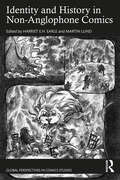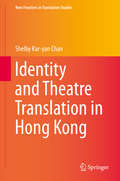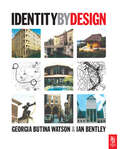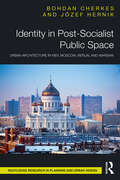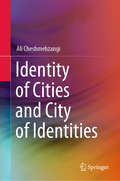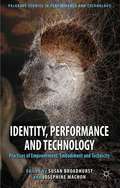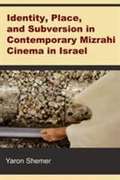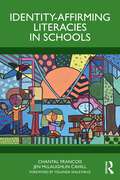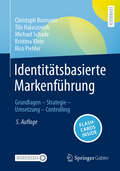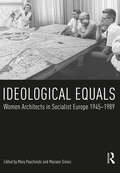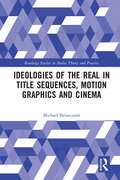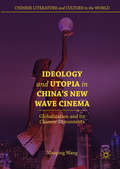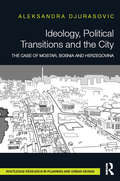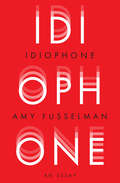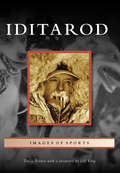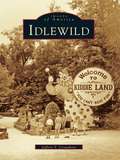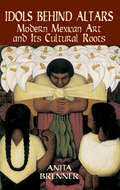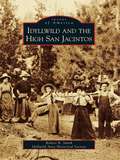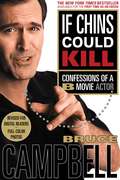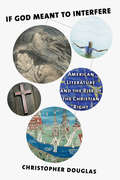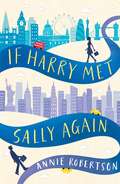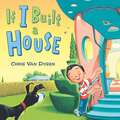- Table View
- List View
Identity and History in Non-Anglophone Comics (Global Perspectives in Comics Studies)
by Harriet E.H. Earle and Martin LundThis book explores the historical and cultural significance of comics in languages other than English, examining the geographic and linguistic spheres which these comics inhabit and their contributions to comic studies and academia. The volume brings together texts across a wide range of genres, styles, and geographic locations, including the Netherlands, Colombia, Greece, Mexico, Poland, Finland, Portugal, Ireland, and the Czech Republic, among others. These works have remained out of reach for speakers of languages other than the original and do not receive the scholarly attention they deserve due to their lack of English translations. This book highlights the richness and diversity these works add to the corpus of comic art and comic studies that Anglophone comics scholars can access to broaden the collective perspective of the field and forge links across regions, genres, and comic traditions. Part of the Global Perspectives in Comics Studies series, this volume spans continents and languages. It will be of interest to researchers and students of comics studies, literature, cultural studies, popular culture, art and design, illustration, history, film studies, and sociology.
Identity and Theatre Translation in Hong Kong
by Shelby Kar-yan ChanIn this book, Shelby Chan examines the relationship between theatre translation and identity construction against the sociocultural background that has led to the popularity of translated theatre in Hong Kong. A statistical analysis of the development of translated theatre is presented, establishing a correlation between its popularity and major socio-political trends. When the idea of home, often assumed to be the basis for identity, becomes blurred for historical, political and sociocultural reasons, people may come to feel "homeless" and compelled to look for alternative means to develop the Self. In theatre translation, Hongkongers have found a source of inspiration to nurture their identity and expand their "home" territory. By exploring the translation strategies of various theatre practitioners in Hong Kong, the book also analyses a number of foreign plays and their stage renditions. The focus is not only on the textual and discursive transfers but also on the different ways in which the people of Hong Kong perceive their identity in the performances.
Identity by Design
by Georgia Butina-Watson Ian BentleyIn a world of increasing globalisation, where one high street becomes interchangeable with the next, Identity by Design addresses the idea of place-making and the concept of identity, looking at how these things can be considered as an integral part of the design process.Structured around a series of case studies including Prague, Mexico, Malaysia and Boston, the authors discuss an array of design approaches to explain and define the complex interrelated concepts. The concluding sections of the book suggest ideas for practical application in future design processes. With full colour images throughout, this book takes the discussion of place-identity to the next level, and will be valuable reading for all architects, urban designers, planners and landscape architects.
Identity in Post-Socialist Public Space: Urban Architecture in Kiev, Moscow, Berlin, and Warsaw
by Józef Hernik Bohdan CherkesThis book is a comparative analysis of the architecture of central public spaces of capital cities in Central and Eastern Europe during the period of their authoritarian and post-authoritarian development. It demonstrates that national identity transformations cause structural changes in urban public spaces, and theorises identity and national identity within urban planning in order to explain the influence of historical, cultural, mental, social as well as ideological and political conditions on the processes of shaping and perceiving the architecture of public space. The book addresses the process of shaping and restructuring historic centres of European capital cities of Kiev, Moscow, Berlin, and Warsaw, which developed under authoritarian regime conditions throughout the 20th century and were characterised by ideological determinism and the influence of state ideology and politics on the architecture of public spaces. The book will be useful for urban planners, architects, land management specialists, art historians, political scientists, and readers interested in the theory and history of cities, the fundamentals of urban planning and architecture, and the planning of cities and public spaces.
Identity in Post-Socialist Public Space: Urban Architecture in Kiev, Moscow, Berlin, and Warsaw (Routledge Research in Planning and Urban Design)
by Józef Hernik Bohdan CherkesThis book is a comparative analysis of the architecture of central public spaces of capital cities in Central and Eastern Europe during the period of their authoritarian and post-authoritarian development. It demonstrates that national identity transformations cause structural changes in urban public spaces, and theorises identity and national identity within urban planning in order to explain the influence of historical, cultural, mental, social as well as ideological and political conditions on the processes of shaping and perceiving the architecture of public space. The book addresses the process of shaping and restructuring historic centres of European capital cities of Kiev, Moscow, Berlin, and Warsaw, which developed under authoritarian regime conditions throughout the 20th century and were characterised by ideological determinism and the influence of state ideology and politics on the architecture of public spaces. The book will be useful for urban planners, architects, land management specialists, art historians, political scientists, and readers interested in the theory and history of cities, the fundamentals of urban planning and architecture, and the planning of cities and public spaces.
Identity of Cities and City of Identities
by Ali CheshmehzangiThis book explores the hybridity of urban identities in multiple dimensions and at multiple scales, how they form as catalysts and mechanisms for urban transitions, and how they develop as city branding strategies and urban regeneration methods. Due to rapid globalisation, the notion of identity has become scarcer, more fragile, and inarguably more important. Given the significance of place and displacement for contemporary everyday life, and the continuous advancement of technologies, identifying relations and values that define humans and their environments in various ways has become crucial.Divided into seven chapters, this book provides extensive coverage of ‘urban identity’, an often-overlooked topic in the fields of urbanism, urban geography, and urban design. It approaches the topic from a novel dual perspective, by exploring cities with tangible commonalities and shared strategies for refining their identities, and by highlighting cities and urban environments characterised by multiple identities. Based on a decade of research in this field, the book provides a multi-disciplinary perspective on urban identity. In addition to comprehensive information for students, it offers a key reference guide for urbanists, urban designers and geographers, architectural and urban practitioners, decision-makers, and governing bodies involved in urban development strategies.
Identity, Performance and Technology
by Susan Broadhurst Josephine MachonThis project investigates the implications of technology on identity in embodied performance, opening up a forum of debate exploring the interrelationship of and between identities in performance practices and considering how identity is formed, de-formed, blurred and celebrated within diverse approaches to technological performance practice.
Identity, Place, and Subversion in Contemporary Mizrahi Cinema in Israel
by Yaron ShemerIn Identity, Place, and Subversion in Contemporary Mizrahi Cinema in Israel , Yaron Shemer presents the most comprehensive and systematic study to date of Mizrahi (Oriental-Jewish or Arab-Jewish) films produced in Israel in the last several decades. Through an analysis of dozens of films the book illustrates how narratives, characters, and space have been employed to give expression to Mizrahi ethnic identity and to situate the Mizrahi within the broader context of the Israeli societal fabric. The struggle over identity and the effort to redraw ethnic boundaries have taken place against the backdrop of a long-standing Zionist view of the Mizrahi as an inferior other whose “Levantine” culture posed a threat to the Western-oriented Zionist enterprise. In its examination of the nature and dynamics of Mizrahi cinema (defined by subject-matter), the book engages the sensitive topic of Mizrahi ethnicity head-on, confronting the conventional notion of Israeli society as a melting pot and the widespread dismissal of ethnic divisions in the country. Shemer explores the continuous marginalization of the Mizrahi in contemporary Israeli cinema and the challenge some Mizrahi films offer to the subjugation of this ethnic group. He also studies the role cultural policies and institutional power in Israel have played in shaping Mizrahi cinema and the creation of a Mizrahi niche in cinema. In a broader sense, this pioneering work is a probing exploration of Israeli culture and society through the prism of film and cinematic expression. It sheds light on the play of ethnicity, class, gender, and religion in contemporary Israel, and on the heated debates surrounding Zionist ideology and identity politics. By charting a new territory of academic inquiry grounded in an interdisciplinary theoretical framework, the study contributes to the formation of “Mizrahi Cinema” as a recognized and vibrant scholarly field.
Identity-Affirming Literacies in Schools
by Chantal Francois Jen McLaughlin CahillIn Identity-Affirming Literacies in Schools, Chantal Francois and Jen McLaughlin Cahill combine their teaching, leadership, and research at Pearl Street Collaborative School in New York City to provide an intimate portrayal of what it means to strive toward a humanizing literacy pedagogy.This book weaves the thread from the school’s dreams about humanizing literacy to the everyday work that extended and nurtured those dreams. By elevating urban students’ and teachers’ unique, diverse, but often devalued voices, this book describes how the school’s collaborative and equity-oriented professional culture informed asset-based dispositions and instructional practices through a relationship-oriented independent reading program; robust engagement with diverse texts, including intersectional, young adult, LGBTQ+ literature; opportunities to foster empathy; rich, text-based discussions; and teacher-designed authentic literacy assessments. This book explores opportunities for students to fluidly engage with their identities, knowledge about the world, the school community, and texts.Identity-Affirming Literacies in Schools will appeal to pre- and in-service educators, especially those considering secondary literacy education and social change, who may use this book for coursework or professional learning.
Identitätsbasierte Markenführung: Grundlagen - Strategie - Umsetzung - Controlling
by Christoph Burmann Tilo Halaszovich Michael Schade Rico Piehler Kristina KleinDieses Lehrbuch liefert einen theoretisch fundierten und sehr gut verständlichen Überblick der identitätsbasierten Markenführung als dem leistungsfähigsten, aktuellsten Ansatz zum erfolgreichen Management von Marken. Dabei stehen die Gestaltung der Markenidentität als interne Seite einer Marke und das externe Markenimage bei Nachfragern im Mittelpunkt. Neben den Grundlagen wird detailliert auf den Managementprozess der identitätsbasierten Markenführung eingegangen. Hierbei werden Fragestellungen wie die Markenpositionierung, die Gestaltung der Markenarchitektur, die Markenevolution und das Management von Brand Touch Points und der Customer Journey thematisiert. Ferner werden mit der internationalen Markenführung, dem Markenmanagement von Retailer- und Herstellermarken im Kontext der Plattformökonomie sowie der Markenführung in Online- und sozialen Medien besondere Anwendungsfälle der identitätsbasierten Markenführung behandelt. Die Ausführungen werden durch zahlreiche anschauliche Beispiele erläutert, welche die gute Anwendbarkeit der identitätsbasierten Markenführung in der Praxis belegen. In der 5. Auflage wurden alle Kapitel grundlegend überarbeitet und neue Praxisbeispiele integriert. Aktuelle Themen, wie z. B. Corporate Social Responsibility (CSR) als Bestandteil des strategischen Markenmanagements, wurden ergänzt und die besonderen Anwendungsfälle der identitätsbasierten Markenführung umfassend überarbeitet. Zusatzmaterial erhalten Sie via App: Laden Sie die Springer Nature Flashcards-App kostenlos herunter und nutzen Sie als Printbuchkäufer exklusive Inhalte, um Ihr Wissen zu prüfen. Der Inhalt Grundlagen der identitätsbasierten Markenführung Strategisches und operatives Markenmanagement Identitätsbasiertes Markencontrolling Internationale identitätsbasierte Markenführung Identitätsbasierte Markenführung im Einzelhandel, in sozialen Medien und auf Plattformen
Ideological Equals: Women Architects in Socialist Europe 1945-1989
by Mary Pepchinski Mariann SimonIdeological Equals: Women Architects in Socialist Europe 1945-1989 presents an alternative narrative of women in architecture. A topic often considered from the perspective of difference, this edited collection conversely focuses on the woman architect in a position of equality with their male counterparts. The book looks at nations in Eastern Europe under Socialism where, between 1945 and 1989, a contrasting vision of gender relations was propagated in response to the need for engineers and architects. It includes contributions from established and emerging academics in the fields of 20th century history, art history, and architectural history in Central and Eastern Europe exploring the political, economic and social mechanisms which either encouraged or limited the rise of the woman architect. Investigating the inherent contradictions of Socialist gender ideology and practice, this illustrated volume examines the individuals in different contexts; the building types the women produced; the books and theory they were able to write; their contacts to international organizations; and their representation on both sides of the Iron Curtain.
Ideologies of the Real in Title Sequences, Motion Graphics and Cinema (Routledge Studies in Media Theory and Practice)
by Michael BetancourtThis book explores the question of realism in motion pictures. Specifically, it explores how understanding the role of realism in the history of title sequences in film can illuminate discussions raised by the advent of digital cinema. Ideologies of the Real in Title Sequences, Motion Graphics and Cinema fills a critical and theoretical void in the existing literature on motion graphics. Developed from careful analysis of André Bazin, Stanley Cavell, and Giles Deleuze’s approaches to cinematic realism, this analysis uses title sequences to engage the interface between narrative and non-narrative media to consider cinematic realism in depth through highly detailed close readings of the title sequences for Bullitt (1968), Kolchak: The Night Stalker (1974), The Number 23 (2007), The Kingdom (2008), Blade Runner: 2049 (2017) and the James Bond films. From this critique, author Michael Betancourt develops a modal approach to cinematic realism where ontology is irrelevant to indexicality. His analysis shows the continuity between historical analogue film and contemporary digital motion pictures by developing a framework for rethinking how realism shapes interpretation.
Ideology and Utopia in China's New Wave Cinema: Globalization And Its Chinese Discontents (Chinese Literature And Culture In The World Ser.)
by Xiaoping WangIdeology and Utopia in China’s New Wave Cinema investigates the ways in which New Wave filmmakers represent China in this age of neoliberal reform. Analyzing this paradigm shift in independent cinema, this text explores the historicity of the cinematic form and its cultural-political visions. Through a close reading of the narrative strategy of key films in New Wave Cinema, Xiaoping Wang studies the movement’s impact on film, literature, culture and politics.
Ideology, Political Transitions and the City: The Case of Mostar, Bosnia and Herzegovina
by Aleksandra DjurasovicRecent history has seen Bosnian and Herzegovinian (BiH) cities undergoing several transitions. Their cities have developed under socialism (1945 – 1992), have suffered through the civil war during the 1990s, and during the last twenty years have been undergoing a slow and multifaceted transition to an indeterminate end point. Focusing on the post-socialist, postwar, and neoliberal transitions experienced in BiH, the book shows that planning systems deviated from control-oriented and top-down regulation to flexible approaches for more open for informal development. The book analyzes several levels of planning-related processes: the former Yugoslavia, BiH, the city of Mostar, and three urban zones (the Industrial Zone Bišće Polje, the City Zone Rondo, and the Historic District and the Old Town Zone) in order to offer insights into the new planning systems in the late phase of post-socialist transition.
Idiophone: An Essay
by Amy Fusselman“This book, about ballet and beauty, philosophy and family, reinforces Amy Fusselman’s status as one of our best interrogators of how we live now.” —Dave Eggers Leaping from ballet to quilt making, from The Nutcracker to an Annie-B Parson interview, Idiophone is a strikingly original meditation on risk-taking and provocation in art and a unabashedly honest, funny, and intimate consideration of art-making in the context of motherhood, and motherhood in the context of addiction. Amy Fusselman’s compact, beautifully digressive essay feels both surprising and effortless, fueled by broad-ranging curiosity, and, fundamentally, joy. “Fusselman bounds with great dexterity from theme to theme—covering topics including addiction, motherhood, gender, and art—until she has transformed the traditional essay into something far wilder and more alive.” —Publishers Weekly, starred review “No one acrobats between beauty, confession, rueful humor, and deep insight with such amazing trapeze-y ease as Amy Fusselman.” —John Hodgman
Iditarod (Images of Sports)
by Tricia Brown Jeff KingFor sled dog-racing fans worldwide, the most important calendar day is the first Saturday in March, when teams convene for the start of mushing's Superbowl--the Iditarod Trail Sled Dog Race®. Every year, as it has since 1973, this ultimate challenge begins in the state's most populated city, Anchorage, and then dives into the Alaska Bush on a historic trail that wends over mountain ranges, along frozen rivers, and onto the Bering Sea ice. The finish line lies 1,000-plus miles away in Nome, beneath a giant, burled archway. There, dogs and their drivers are greeted by masses of locals, vacationing fans, officials, media, and other mushers who intimately know what that team has just endured. To simply finish is the goal for entrants; to win is the accomplishment of a rare few. Indeed, more people have climbed Mount Everest than have finished the Iditarod®.
Iditarod Memories: 30 Years of Poster Art from the Last Great Race
by Jona Van ZyleA collection of annual posters from the official artist of the Iditarod Trail Sled Dog Race. Included are stories about how each of the first 30 posters came to be created, and the stories they tell about the race.
Idlewild (Images of America)
by Jeffrey S. CroushoreLocated in the scenic Laurel Highlands of western Pennsylvania, America's third oldest amusement park, Idlewild, was founded in 1878 as a picnic ground along the Ligonier Valley Rail Road. Its tranquil setting quickly established Idlewild as the premier place for church, school, and corporate picnics, as well as a recreational getaway for families. Idlewild added new amusements and facilities as its crowds continued to grow, but it always strove to maintain the picturesque landscape of the site. Soon a full-fledged amusement park was in operation, with throngs of visitors disembarking the trains from such places as Latrobe, Greensburg, and Pittsburgh.Home to unique attractions like Story Book Forest, the Rollo Coaster, Mister Rogers' Neighborhood of Make-Believe, and the SoakZone, Idlewild has been the backdrop for generations of fond memories. Idlewild's proximity to the Lincoln Highway helped the park survive the abandonment of the railroad, and careful development by the Mellon and Macdonald families and the Kennywood Entertainment Company continue to help it thrive. This collection of photographs tells the story of how one of America's most beautiful theme parks has grown throughout the years.
Idols Behind Altars: Modern Mexican Art and Its Cultural Roots
by Anita BrennerArt critic, historian and journalist Anita Brenner (1905-1974) is acknowledged to be one of the most important and perceptive writers on the art, culture, and political history of Mexico. Idols Behind Altars is her influential historical and critical study of modern Mexican art and its roots. It was one of the first books to afford Mexican art the same serious considerations as European and Asian art and remains indispensable for anyone interested in the subject. The works of such major figures as Diego Rivera, Jóse Clemente Orozco, David Alfaro Siqueiros, Francisco Goitia and Jean Charlot are examined in the cultural context of pre-Columbian times through the 19th century. Brenner's astute analysis of Mexican history, her keen insights into revolutionary politics, and her passionate advocacy of Mexican art infuse this book with seminal importance. 117 illustrations--including some early photographs by Edward Weston--enhance the text.
Idyllwild and the High San Jacintos
by Robert B. Smith Idyllwild Area Historical SocietySouthern California's hidden treasure lies in the San Jacinto Mountains. Capped by the last 10,000-foot peaks on the way to Mexico, these mountains have enriched human lives for centuries. Discovered by loggers in 1876, partially stripped of their trees during California's first population boom in the 1880s, then protected by federal edict in 1897, these mountains attracted a special breed of settler. The uncommon village of Idyllwild was created by common people who were enchanted by the surrounding forest wilderness. Isolated here, high above the chaos of modern life, they have preserved a vestige of mid-20th-century small-town America in the woods. This collection of around 200 previously unpublished photographs, including stunning images by the gifted photographers Avery Field and Harry Wendelken, offers glimpses of the paths along which village and wilderness have shaped each other.
Idée d'aménagement de piscine: Comment amenager et sécuriser votre piscine
by Owen JonesDescription du livre: J'espère que vous trouverez les informations utiles, utiles et profitables. Les informations contenues dans ce livre électronique sur la façon de tirer le meilleur parti de toutes les idées que vous pouvez avoir au sujet d'une piscine domestique sont organisées en 17 chapitres d'environ 500 à 600 mots chacun. J'espère qu'elles intéresseront ceux qui souhaitent créer une piscine domestique ou en tirer le meilleur parti. Il sera également utile à ceux qui envisagent de se lancer dans la création ou l'entretien de piscines. Il s'agit toutefois d'un guide pour débutants, mais j'espère qu'il suffira à vous intéresser ou à vous lancer. En prime, je vous autorise à utiliser le contenu de ce guide sur votre propre site web ou dans vos blogs et bulletins d'information, mais il est préférable que vous le réécriviez d'abord avec vos propres mots. Vous pouvez également diviser le livre et revendre les articles. En fait, le seul droit que vous n'avez pas est de revendre ou de donner le livre tel qu'il vous a été livré.
If Chins Could Kill: Confessions of a B Movie Actor
by Bruce CampbellIf Chins Could Kill: Confessions of a B Movie Actor Here we are together in the digital universe. Somehow, you've clicked yourself to this page. If you came here of your own free will and desire, you and I are going to get along just fine. Life is full of choices. Right now, yours is whether or not to download the autobiography of a mid-grade, kind of hammy actor. Am I supposed to know this guy? you think to yourself.No-and that's exactly the point. You can download a terabyte of books about famous actors and their high-falootin' shenanigans. I don't want to be a spoilsport, but we've all been down that road before. Scroll down to that Judy Garland biography. You know plenty about her already-great voice, troubled life. Scroll down a little further to the Charlton Heston book. Same deal. You know his story too-great voice, troubled toupee. The truth is that though you might not have a clue who I am-unless you watch cable very late at night-there are countless working stiffs like me out there, grinding away every day at the wheel of fortune. If Chins Could Kill: Confessions of a B Movie Actor documents my time in blue-collar Hollywood, where movies are cheap, the hours are long, and the filmmaking process can be very personal. To keep up with the times, I've digitized Chins. It was originally published in hardcover/analog fifteen years ago, which is a vast amount of time in the evolution of books and technology, and it was time to get current. The advance of technology is great for a book like this, which is jammed full of pictures. When it came out originally, the photographs all had to be black and white and moderately sized on the page. Now, any photo that was originally taken in color can strut its stuff. Overall, the resolution of the images is off-the-charts better than the first go-around. This is one "sequel" that I'm happy to be a part of, since we could make so many technical improvements. The process was very similar to restoring an old movie.Since I knew that it was going to be reissued, I also had a look at the story being told and decided to condense, move, or clarify some chapters, all or in part. I also tried to add a hint of historical context, since it has been a decade and a half since Chins first came out.I hope you enjoy it. Regards,Bruce Campbell
If God Meant to Interfere: American Literature and the Rise of the Christian Right
by Christopher DouglasThe rise of the Christian Right took many writers and literary critics by surprise, trained as we were to think that religions waned as societies became modern. In If God Meant to Interfere, Christopher Douglas shows that American writers struggled to understand and respond to this new social and political force. Religiously inflected literature since the 1970s must be understood in the context of this unforeseen resurgence of conservative Christianity, he argues, a resurgence that realigned the literary and cultural fields. Among the writers Douglas considers are Marilynne Robinson, Barbara Kingsolver, Cormac McCarthy, Thomas Pynchon, Ishmael Reed, N. Scott Momaday, Gloria Anzaldúa, Philip Roth, Carl Sagan, and Dan Brown. Their fictions engaged a wide range of topics: religious conspiracies, faith and wonder, slavery and imperialism, evolution and extraterrestrial contact, alternate histories and ancestral spiritualities. But this is only part of the story. Liberal-leaning literary writers responding to the resurgence were sometimes confused by the Christian Right's strange entanglement with the contemporary paradigms of multiculturalism and postmodernism —leading to complex emergent phenomena that Douglas terms "Christian multiculturalism" and “Christian postmodernism.” Ultimately, If God Meant to Interfere shows the value of listening to our literature for its sometimes subterranean attention to the religious and social upheavals going on around it.
If Harry Met Sally Again: the perfect feel-good romantic comedy
by Annie RobertsonThe perfect feel-good romantic comedy - When Harry Met Sally for the 21st centuryCan you write your own happy ending...?When Nina discovers her boyfriend in bed with another woman, she decides it's finally time to channel the spirit of her idol, Nora Ephron, and become the heroine of her own life.Her sequel to the most beloved romcom of all time - If Harry Met Sally - has been gathering dust in her desk drawer for years, but her best friend Astrid convinces her that this is the perfect moment to finish her script and make it as the Hollywood screenwriter she always wanted to be.There's nothing standing between Nina and her dream - apart from cynical film producers, her parents' mid-life crises, Astrid's turbulent marriage, and Ben, her utterly infuriating co-writer... As her life becomes ever more complicated, Nina must choose between seizing her chance of success, and staying true to what she's always wanted - for Harry, Sally and herself. It seems like happy endings are hard to come by, even when you're writing the script... Hilarious and heartwarming, this is the perfect romantic read for fans of Sophie Kinsella and Mhairi McFarlane, and everyone who loves When Harry Met Sally and You've Got Mail.
If I Built a House (If I Built Series)
by Chris Van DusenThe much-anticipated follow-up to the E. B. White Award-winning picture book If I Built a Car In If I Built a Car, imaginative Jack dreamed up a whimsical fantasy ride that could do just about anything. Now he's back and ready to build the house of his dreams, complete with a racetrack, flying room, and gigantic slide. Jack's limitless creativity and infectious enthusiasm will inspire budding young inventors to imagine their own fantastical designs. Chris Van Dusen's vibrant illustrations marry retro appeal with futuristic style as he, once again, gives readers a delightfully rhyming text that absolutely begs to be read aloud.
